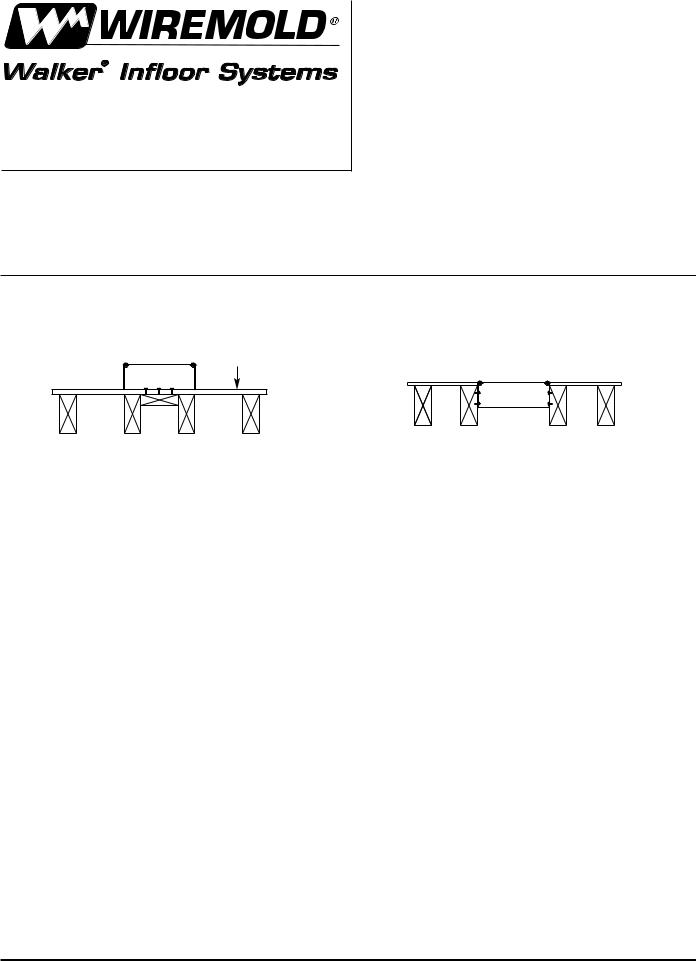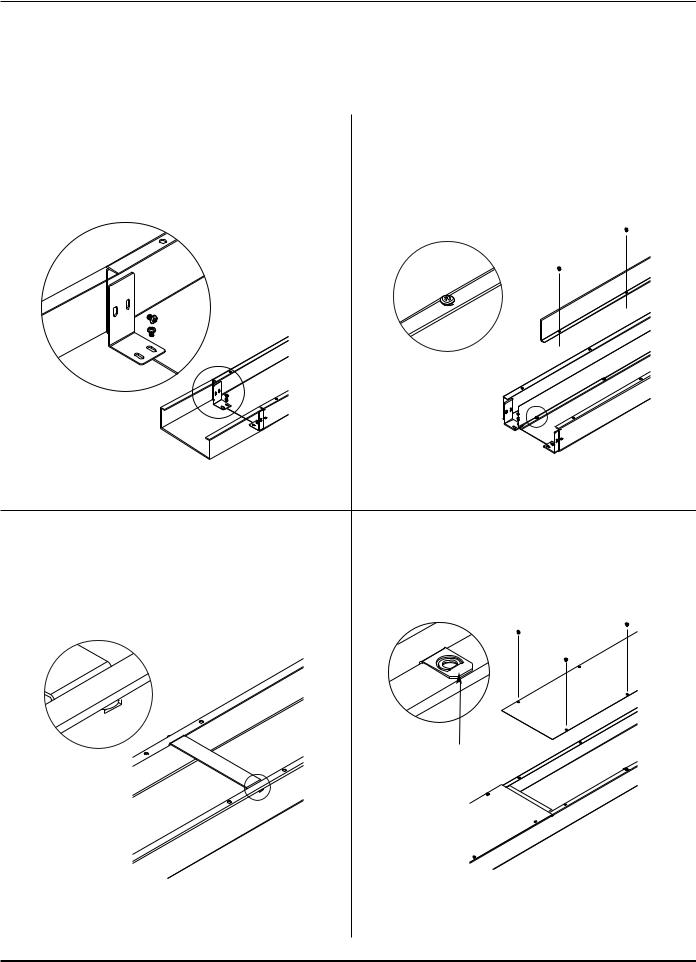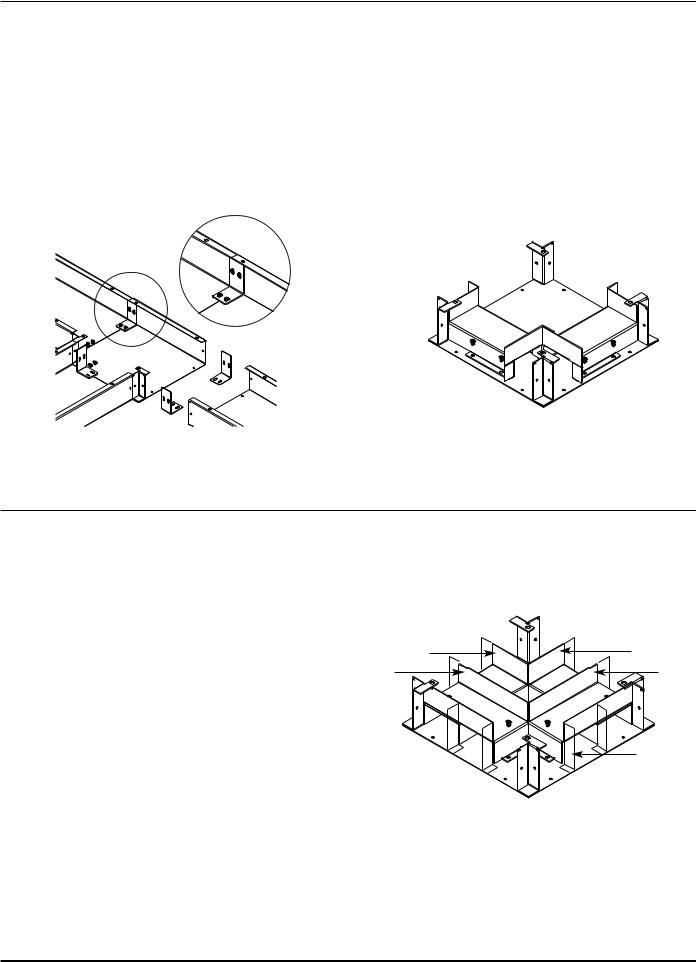Legrand Wallduct Medical Raceway System Bodies User Manual

Wallduct Bodies & Fittings |
INSTALLATION INSTRUCTIONS |
Installation Instruction No.: 1 002 623 – January 2003 |
Walker® electrical systems conform to and should be properly grounded in compliance with requirements of the current National Electrical Code or codes administered by local authorities.
All electrical products may present a possible shock or fire hazard if improperly installed or used. Walker electrical products may bear the mark as UL Listed and/or Classified and should be installed in conformance with current local and/or the National Electrical Code.
IMPORTANT – PLEASE READ ALL INSTRUCTIONS BEFORE BEGINNING.
Products Covered: Steel and aluminum raceway bodies, fittings, and accessories with catalog numbers beginning with the following prefix: WD, AWD, CP, ACP, VA, or AVA.
Raceway and fittings may be mounted directly to a wall/ ceiling surface, or mounted within the wall/ ceiling so that the cover plate is flush with the mounting surface (see illustration below).
Wall Surface
Wall
 Stud
Stud
Thru Surface Wallduct |
Thru Flush Wallduct |
Mounting means and hardware are not provided. Raceway and fittings must be secured to the mounting surface at intervals not exceeding 4 feet [1.2m] when wall mounted vertically or horizontally with a minimum of 4 drywall screws with a length of 2.00" [5.08cm] with a coarse thread pattern. A spacing of 2 feet [.610m] is recommended. The portion of the fastener that resides inside the raceway must be free of sharp edges or any surfaces that may abrade the internal cabling. Mounting holes must be field drilled into the raceway and fittings. Make sure screws applied meet your specific load applications and that the mounting surface material will support the load of the raceway and fittings, and the additional load of the internal cabling. When mounting from a ceiling, consult manufacturer of support means to make sure load applied can be properly supported. In order to do this you must calculate the wire and duct weight over the desired distance between supports.
When assembling adjacent sections of raceway and fittings together using the coupling angles and hole locations provided, screws must be tightened to a torque of 35 inch-pounds [3.953 Nm]. Use a #18 drill, diameter of .170" [4.31mm] for field drilled hole locations where #10-32 taptite screws are being used. Suggested torque value for taptite screws is 25 inch-pounds [2.823Nm]. For coverplates or other locations where palnut clips are to be used, a hole of 9/32" [7.143mm] is required. Cover plates must be secured to the raceway and fittings with the screws provided to a torque value of 30 inch-pounds [3.388 Nm].
All field cut edges or corners must be filed smooth or a grommet added to prevent damage to internal cabling and personal injury. The installer must take special care when installing internal tunneling and partitions to prevent any gaps or openings greater than 1/16" [1.59mm] in width.
Raceway and fittings must be grounded in accordance to the NEC and any other local codes that apply. Any paint that is applied to the raceway must be removed in the locations where the grounding means (not provided by Walker Systems, Inc.) is attached. Raceway system is intended for power conductors 4/0 or smaller and circuits operating at potentials not exceeding 600 volts between conductors.

SPECIFIC INSTRUCTIONS: STRAIGHT BODIES AND THEIR COMPONENTS
Follow the instructions on page 1 for surface mounting application. Bodies are supplied from factory with wire retainers, coupling angles, and necessary fasteners. Fasteners to mount bodies to wall are supplied by installer. Access cover plates not shown here are installed similar as described for cover plates shown below. Apply supplied grommet to access cover plates.
Step 1 Bodies need to be butted together using coupling angles provided and #10-32 "taptite" screws. All screws are required for proper electrical bonding between bodies and attachment to wall.
Step 2 With bodies connected and mounted to wall with screws, place partitions into duct as necessary making sure wire fill requirements are followed as per NEC (Wire fill information
is also located onlast page of instruction sheet).
Step 3 Place wires into duct and then slide wire retainers into place (wires not shown for clarity). The wire retainer fits in slots located at the end of each duct body and in the middle of a 60" [1,524mm] body.
Step 4 To attach cover, place palnut clip over holes on top side of duct as shown. Position cover and secure into place using #10-32 machine screws provided.
Palnut Clip

SPECIFIC INSTRUCTIONS: REDUCER COUPLINGS, END CLOSURES, FLANGED CABINET CONNECTORS, AND VA RISERS.
Reducer couplings are used for transitions from a larger to a smaller width duct of the same depth. End closures are used to close end of duct. Both are attached using #10-32 taptite screws. Flanged cabinet connectors connect duct bodies to cabinets of various sizes. VA Riser transition trenchduct to wallduct. All screws are required for proper electrical bonding.
Step 1 For Reducer Couplings – Place one reducer |
Step 1 For End Closures – Fasten closure to body of |
onto the inside of the duct and attach as you |
duct using screws provided. The closure should |
would a coupling angle. Repeat for the other |
be attached just like a coupling angle. |
reducer coupling as necessary. |
|
NOTE: When transitioning from a larger duct body to a smaller |
NOTE: This should be done prior to installation of any wires, |
duct body, follow all wire fill requirements according to |
coverplates, and wire retainers. |
UL and the last page of this instruction sheet. |
|
Step 1 For Flanged Cabinet Connectors – |
Step 1 For VA Risers – Attach riser to duct body using |
Connect flanged cabinet connector using |
coupling angles provided with duct body and |
coupling angles and screws provided |
attach to trench body using screws provided |
(similar to connecting two pieces of straight |
through tabs provided with the VA body. |
wallduct). Attach to cabinet using holes |
|
provided and approporiate screws (provided |
|
by others). |
|

SPECIFIC INSTRUCTIONS: T-UNITS, X-UNITS, ELBOWS, AND COMPARTMENT TUNNELS
T-Units, X-Units, and Elbows are used for multiple runs of duct that come together in the same location or to make a sharp turn at the end of one run and the beginning of another. Compartment tunnels are used to run different feeds (power and communication, ex.) through the same duct bodies. Internal, external, and sweep elbows not shown here are installed similar to T-Units shown below.
Step 1 For T-Units, X-Units, and Elbows – Unit attaches with coupling angles similar to standard wallduct bodies (page 2). Make sure to use proper screw torque when connecting bodies.
Step 1 For 2 Compartment X-Units Tunnels –
Position tunnel in X-Unit as shown before wiring is installed. Using holes in the tunnel flange as a guide, drill .170" dia. (#18 drill, [4.318mm]) holes through the bottom of the X-Unit.
NOTE: Make sure to follow all bend radius requirements when installing wires into duct.
Step 1 For 3 Compartment X-Unit Tunnels – Follow previous instructions for X-unit tunnels. If the partition of the adjoining wallduct sections have not been installed prior to the assembly of the X-unit tunnels / bridges, cut the partition long enough to extend into the X-Unit and abut the tunnel/bridges as shown.
If the partitions of the adjoining Wallduct sections have been installed prior to the assembly of the X-unit tunnels/bridges, cut the partition pieces from excess straight body partitions, as shown below. These pieces are required to fit between the straight body
partitions and the tunnel / bridges of the X-unit.
When bridges overlap tunnels, secure the bridge to the tunnel with a 3/16" pop rivet (provided by others). Use the hole(s) located in the bridge as a guide to drill a 13/64" [5.16 mm] diameter hole for the pop rivet. Select a pop rivet length suitable for the tunnel material thickness installed.
Tunnel
Bridge
Tunnel
Bridge
Partition
NOTE: Using tunnels reduces your overall wire fill capacity by 50% due to reduced area for wires in the system as a whole.
